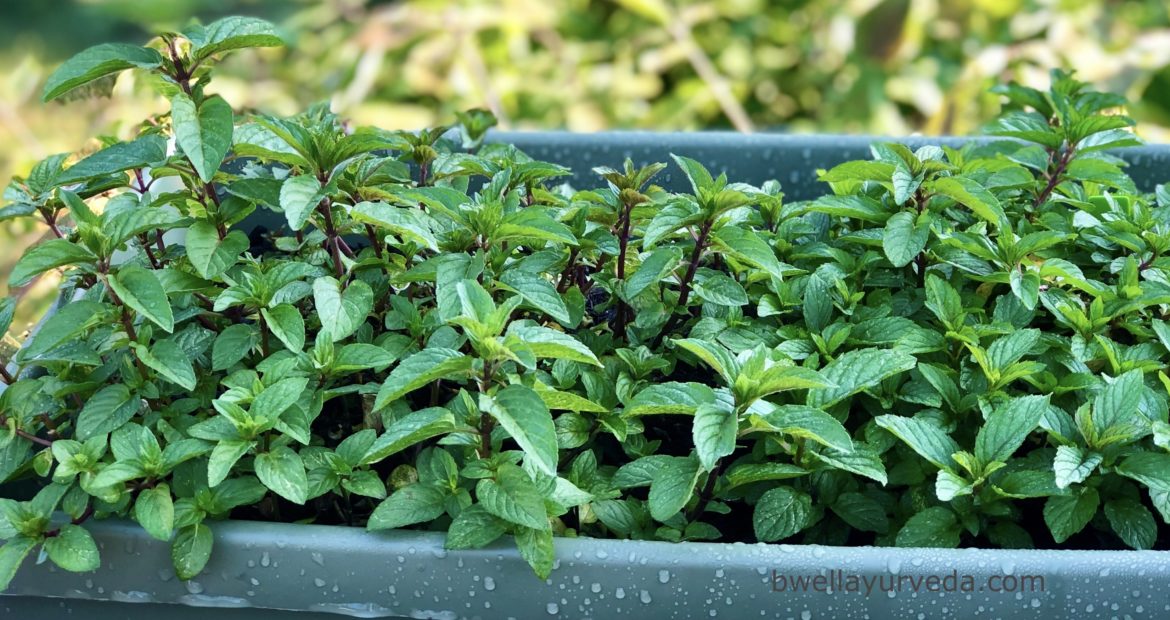Peppermint is a perennial herb, used widely for its culinary and medicinal properties. Peppermint(Mentha x piperita) is part of the mint family (Lamiaceae), a natural hybrid between watermint (Mentha aquatica) and spearmint (M. spicate). Peppermint is cultivated in Asia, Middle East, North America and Europe, often found growing near marshes where water is abundant.
Peppermint has a distinct smell which enlivens the senses. The fragrant aromatic menthol oil clears the sinuses, while also supporting digestion and in smaller amounts, calms the nervous system.
In Ayurveda peppermint is one of the many herbs used for its health benefits to address digestive problems, nausea, colds, cramps, respiratory conditions and more. Ayurveda aims to bring wellness with proper foods and proper digestion to prevent disease, thus food is considered medicine. When you eat foods and herbs to help balance your body type or dosha, you feel nourished and energized.
Ayurvedic Energetics for Peppermint:
- Dosha Effect PK-, V+ (pacifies pitta and kapha, aggravates vata in excess)
- Rasa (taste) Sweet, pungent
- Vırya (energy) Cooling and heating
- Vipaka (post-digestive effect) Pungent
- Guna (quality) Light, dry, penetrating
- Dhatu (tissue) Plasma, blood, nerve
- Srotas (channel) Digestive, circulatory, respiratory, nervous
Ayurvedic and Biomedical Actions for Peppermint:
- Dıpana- enkindles appetite, digestive
- Anuloma- redirects the flow of vata downwards
- Svedana- diaphoretic: inducing perspiration, dispels fever, support circulation and removal of toxins.
- Sirovirecana- purges the orifices of the head
- Carminative -prevents or helps to expel gas, bloating, alleviates abdominal cramping
- Analgesic-pain relief
- Antispasmodic-relaxes muscles
- Antipruritic- dispels heat, fever, fire
- Nervine-calms nervous tension and nourish nervous system.
- Aromatic-clears, refreshes and energizes
Ayurvedic Peppermint Recipes PRINT
Refreshing Peppermint – Lime Infused Water
I enjoy drinking water infused with fresh peppermint in the summer time. Even though it has a pungent taste which is associated with creating or increasing heat in the body, peppermint generally disperses heat, leaving a cooling effect.
Ingredients:
- 4 fresh mint leaves
- 2 tablespoons fresh lime juice
- 1 tsp. maple syrup (optional)
- 10 oz of filtered water
- In a tall glass, muddle the mint lightly, then pour the lime juice and maple syrup if using.
- Add filtered water.
- Mix and enjoy.
Fresh Peppermint Tea
Serves 2
Ingredients
- 2 C water hot water (180 deg F)
- 4 sprigs fresh mint
Add fresh 2 mint sprigs in a mug, then add water. Steep for 5 minutes or longer, then enjoy.
Betty’s Quinoa Tabbouleh
Ingredients
- 1 cup white quinoa
- 2 cups water
- 1/4 cup diced red onion
- 1/8 tsp. coriander powder
- 1/8 tsp. fennel powder
- 1 pint sweet cherry tomatoes, halved
- 1 cup diced cucumbers (I prefer English cucumbers with very tiny seeds and thin skin)
- 2/3 cup finely chopped fresh mint
- 1 cup finely chopped fresh flat-leaf parsley
- 2 Tbsp. freshly squeezed lemon juice-plus a little extra (or lime juice)
- 1/4 -1/2 cup Extra virgin olive oil to taste (optional)
- Sea salt and fresh black pepper to taste
Preparation
- Rinse the quinoa with cool water.
- Boil the water in a saucepan on high heat.
- Then add quinoa and decrease heat to low, simmer for about 15 minutes or until all the water has been absorbed.
- Remove from heat and let stand for 5 minutes. Fluff with a fork. Let the quinoa cool completely before making the salad.
- In a large bowl, place the quinoa and all of the ingredients; stir well, adding extra lemon juice, extra virgin olive oil and salt and fresh black pepper to taste as needed.
Peppermint also contains trace amounts of minerals and vitamins:
- potassium
- magnesium
- calcium
- phosphorus
- vitamin C
- iron
- vitamin A
Mint can be beneficial as a replacement for salty, sugary, or calorific flavorings.
Resources:
https://ayurmantra.com/pudina-peppermint.html
https://pubmed.ncbi.nlm.nih.gov/16767798/
https://www.medicalnewstoday.com/articles/275944#nutrition
https://www.britannica.com/plant/peppermint
